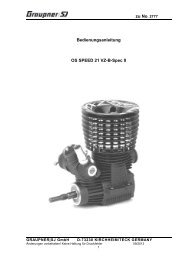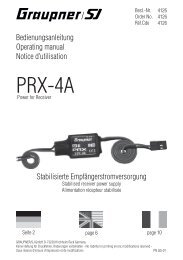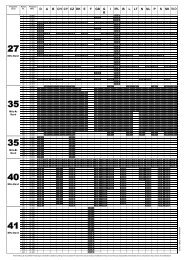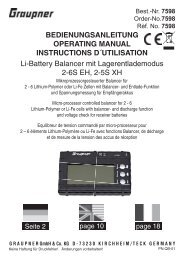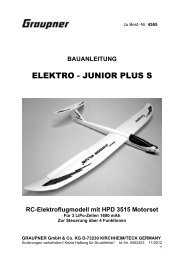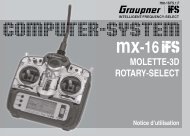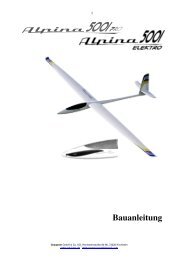Bauanleitung Alpina 4001_ Elektro Graupner_2010_DEF
Bauanleitung Alpina 4001_ Elektro Graupner_2010_DEF
Bauanleitung Alpina 4001_ Elektro Graupner_2010_DEF
You also want an ePaper? Increase the reach of your titles
YUMPU automatically turns print PDFs into web optimized ePapers that Google loves.
24<br />
Remove just sufficient polystyrene to the inside<br />
the factory prepared servo-wells to accommodate<br />
your chosen servos. Alternatively remove all of the<br />
polystyrene to reveal the inside of the upper wing<br />
skin and then apply a layer of suitably treated 100<br />
gr / m² glass cloth to prevent any indentations<br />
appearing in the upper surface of the wing when<br />
the servos are installed.<br />
Installation of the airbrakes<br />
For those customers who have purchased the<br />
Carbon Master Edition (CME) with the built-in<br />
air- brakes - please complete the following<br />
additional steps:<br />
Carefully remove the foil around the airbrake<br />
opening to reveal the factory installed airbrakes.<br />
Refer to the instructions for assembly, dismantling<br />
and installation of the airbrake mechanisms given<br />
in the Appendix.<br />
The supplied self adhesive white plastic strips are<br />
fixed to the upper surface of the airbrakes to form<br />
the airbrake caps. Adjust carefully to achieve<br />
minimum gaps and a good aerodynamically clean<br />
wing surface – as shown.<br />
Fig 8. Airbrake<br />
Installing the wing control horns.<br />
Note: ARF customers will need to remove a little<br />
of the covering material while those building the<br />
ARC version may prefer to wait until after the<br />
wings have been covered before bonding the<br />
control horns in place.<br />
Ailerons: Mark out the position of the aileron<br />
control horns on the lower surface of the aileron.<br />
The horn should be positioned directly opposite<br />
the scoop in the servo cover and about 3 mm from<br />
the aileron leading edge.<br />
Flaps: Similarly locate the slots to accommodate<br />
the supplied GRP control horns about 3mm behind<br />
the leading edge of the flap such that the eye is<br />
located about 10mm behind the flap leading edge<br />
and about 13mm above the lower surface of the<br />
flap.<br />
As before, drill a series of 2mm diameter holes and<br />
cut away the excess to form a neat slot to<br />
accommodate the supplied GRP control horns.<br />
Take care not to cut through to the upper surface<br />
of the aileron and undercut a little of the material<br />
inside the slot to allow for additional adhesive.<br />
Once satisfied with the position of the control<br />
horns, roughen the ends of each and bond the GRP<br />
control horns into place using thickened epoxy and<br />
allow to cure.<br />
Fig 10 – 13. Wing Control Horns<br />
Wing servo wiring.<br />
Given the number of wing servos present, take<br />
time to consider how best to achieve the electrical<br />
connections between the receiver in the fuselage<br />
and the wing servos. Individual aero-modellers<br />
will no doubt have their own preferences, but we<br />
would recommend the use of quality polarised<br />
connectors with Gold plated contacts, a<br />
combination of either D-Type connectors, or high<br />
current (green) plugs & sockets.<br />
Prepare the cable harnesses required to connect the<br />
wing mounted aileron and flap servos to the<br />
receiver system in the fuselage. The connectors<br />
may be either fixed into the wing and/or fuselage,<br />
or left on flying leads. However, it is generally<br />
recommended that at least one side of the cable<br />
harness should be permanently mounted as this<br />
reduces wear and tear on the cables and is more<br />
convenient when rigging the model at the flying<br />
site.<br />
Drill a series of 2mm diameter holes and cut away<br />
the excess to form a neat slot to accommodate the<br />
supplied GRP control horns. Take care not to cut<br />
through to the upper surface of the aileron and<br />
undercut a little of the material inside the slot to<br />
allow for additional adhesive.<br />
Locate the aileron control horn such that the eye is<br />
at 90° to the hinge line and about 12mm above the<br />
lower surface of the aileron.<br />
Regardless of how exactly you choose to proceed,<br />
be sure to use good quality twisted servo leads<br />
with a wire diameter of no less than 0.25 mm ²<br />
capable of delivering adequate current for the<br />
multiple wing servos under load. Pay careful<br />
attention to the solder connections ensuring good<br />
mechanical and electrical joint in each case. Be<br />
sure to insulate each joint with heat-shrink for<br />
additional security. Some may wish to apply a<br />
bead of silicone compound to the soldered ends to<br />
avoid stress points when handling the connectors.<br />
<strong>Graupner</strong> GmbH & Co. KG * Henriettenstraße 94-96 * D - 73230 Kirchheim/Teck * www.graupner.de<br />
Stand: <strong>2010</strong>





